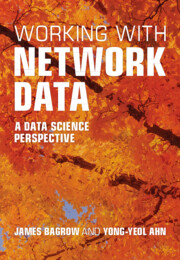Book contents
- Frontmatter
- Contents
- Preface
- Part I Background
- Part II Applications, tools, and tasks
- Chapter 5 The life cycle of a network study
- Chapter 6 Gathering data
- Chapter 7 Extracting networks from data — the “upstream task”
- Chapter 8 Implementation: storing and manipulating network data
- Chapter 9 Incorporating node and edge attributes
- Chapter 10 Awful errors and how to amend them
- Chapter 11 Explore and explain: statistics for network data
- Chapter 12 Understanding network structure and organization
- Chapter 13 Visualizing networks
- Chapter 14 Summarizing and comparing networks
- Chapter 15 Dynamics and dynamic networks
- Chapter 16 Machine learning
- Interlude — Good practices for scientific computing
- Part III Fundamentals
- Conclusion
- Bibliography
- Index
Chapter 6 - Gathering data
from Part II - Applications, tools, and tasks
Published online by Cambridge University Press: 06 June 2024
- Frontmatter
- Contents
- Preface
- Part I Background
- Part II Applications, tools, and tasks
- Chapter 5 The life cycle of a network study
- Chapter 6 Gathering data
- Chapter 7 Extracting networks from data — the “upstream task”
- Chapter 8 Implementation: storing and manipulating network data
- Chapter 9 Incorporating node and edge attributes
- Chapter 10 Awful errors and how to amend them
- Chapter 11 Explore and explain: statistics for network data
- Chapter 12 Understanding network structure and organization
- Chapter 13 Visualizing networks
- Chapter 14 Summarizing and comparing networks
- Chapter 15 Dynamics and dynamic networks
- Chapter 16 Machine learning
- Interlude — Good practices for scientific computing
- Part III Fundamentals
- Conclusion
- Bibliography
- Index
Summary
In working with network data, data acquisition is often the most basic yet the most important and challenging step. The availability of data and norms around data vary drastically across different areas and types of research. A team of biologists may spend more than a decade running assays to gather a cells interactome; another team of biologists may only analyze publicly available data. A social scientist may spend years conducting surveys of underrepresented groups. A computational social scientist may examine the entire network of Facebook. An economist may comb through large financial documents to gather tables of data on stakes in corporate holdings. In this chapter, we move one step along the network study life-cycle. Key to data gathering is good record-keeping and data provenance. Good data gathering sets us up for future success—otherwise, garbage in, garbage out—making it critical to ensure the best quality and most appropriate data is used to power your investigation.
Keywords
- Type
- Chapter
- Information
- Working with Network DataA Data Science Perspective, pp. 73 - 82Publisher: Cambridge University PressPrint publication year: 2024

